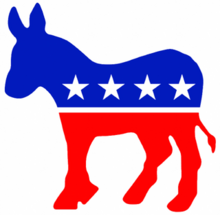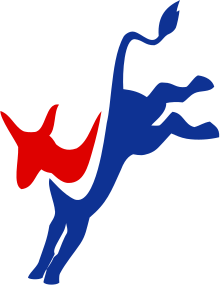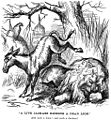History of the United States Democratic Party facts for kids
The Democratic Party of the United States is one of the two main political parties in the country. It's actually the oldest political party in the world that's based on voters! Its history goes all the way back to the 1790s.
From the 1830s to the mid-1850s, under presidents like Andrew Jackson and Martin Van Buren, the Democrats were usually a bit stronger than the Whig Party. Both parties worked hard to get people to vote. They also used a system called patronage to help fund their work. This included growing political groups in big cities and national newspaper networks.
The Democratic Party was popular with farmers, city workers, and new immigrants. It was especially liked by Irish immigrants who became very involved in city politics. However, it was less popular with business owners, plantation owners, and social reformers. The party supported moving west, called "Manifest Destiny", and wanted more equality for all white men. They also opposed national banks. In 1860, the Civil War started between the mostly Republican North and the mostly Democratic, slave-holding South.
After the Civil War, from 1860 to 1932, the Republican Party was usually in charge of the presidency. During these 72 years, the Democrats only elected two presidents: Grover Cleveland (twice) and Woodrow Wilson (twice). However, Democrats were more competitive in Congress. They held the majority in the House of Representatives many times. The party was split between "Bourbon Democrats" who cared about business, and farmers in the South and West. These farmers wanted "free silver" (which meant more money in circulation). They took over the party in 1896 and nominated William Jennings Bryan three times, but he lost each election. Both Bryan and Wilson were leaders of the "Progressive Movement" from the 1890s to the 1920s.
Starting with President Franklin D. Roosevelt in 1932, during the Great Depression, the Democratic Party became very powerful. Their ""New Deal" coalition" brought in new policies to help the country recover from the stock market crash and the depression. They also led the country through World War II. The Democrats controlled the White House until Roosevelt's death in 1945, and then under his successor, Harry S. Truman. A Republican president was not elected again until the early 1950s, when Dwight D. Eisenhower won.
For over 40 years, from 1930 until 1994, the Democrats usually had large majorities in the House of Representatives. They also controlled the U.S. Senate for most of that time. Important Democratic leaders included Presidents Harry S. Truman and Lyndon B. Johnson. The Kennedy brothers—President John F. Kennedy, Senator Robert F. Kennedy, and Senator Ted Kennedy—were also key figures for modern American liberalism. Since 1976, Democrats have won five out of the last ten presidential elections. These winners include Jimmy Carter (1976), Bill Clinton (1992 and 1996), and Barack Obama (2008 and 2012).
Contents
How the Democratic Party Started
Early Years: 1828–1860
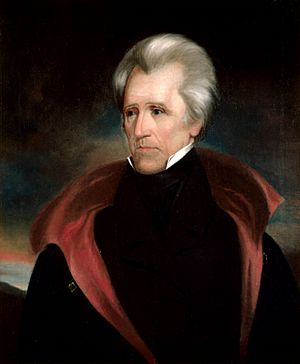
The Democratic Party grew from the Democratic-Republican Party. This earlier party was started by Thomas Jefferson and James Madison. They were against the Federalist Party of Alexander Hamilton. The Jeffersonian Republicans believed in a weak federal government and strong states' rights. They also supported farmers and followed the Constitution very strictly. They did not like a national bank or close ties with Great Britain. This party won the election of 1800.
After the War of 1812, the Federalists mostly disappeared. The Democratic-Republicans were the only major party for a while, in what was called the "Era of Good Feelings". But even this party had different groups inside it. These groups split over who should replace President James Monroe. The group that supported old Jeffersonian ideas, led by Andrew Jackson and Martin Van Buren, became the modern Democratic Party.
In 1828, the Democrats became the first well-organized national party. They used state parties, leaders, and newspapers to get their message out. This strong organization became a key part of American politics in the 1800s.
Other groups, led by Henry Clay, formed the Whig Party. The Democrats were usually a bit stronger than the Whigs until the 1850s. At that time, the Whigs broke apart over the issue of slavery. In 1854, some anti-slavery Democrats left their party. They joined with Northern Whigs to create the Republican Party.
Democrats believed the government should not interfere too much in the economy. They thought government help often benefited special groups and rich people. They wanted to help regular farmers and workers. They also opposed government programs like public schools, believing these interfered with parents' rights. Andrew Jackson, for example, used his veto power a lot to stop laws he didn't like. He also did not support Native Americans, leading to the forced removal of the Cherokees on the Trail of Tears.
Civil War and Beyond: 1860–1900
The Democratic Party split before the 1860 election. This happened because of disagreements between Northern and Southern members over slavery. Southern Democrats wanted to allow slavery in new territories, even if voters there didn't want it. This split led to the Republican Party winning the election, and Abraham Lincoln became president.
During the American Civil War, Northern Democrats were divided. Some supported Lincoln, while others wanted peace. The Southern states, which formed the Confederate States of America, did not have strong political parties. After the war, white Southerners were angry about Reconstruction. They disliked the Republican Party. After Reconstruction ended, and with the disenfranchisement of African Americans, the South became known as the "Solid South" because it voted Democratic.
Even though Republicans won most presidential elections, Democrats remained strong. The party was led by "Bourbon Democrats" like Grover Cleveland. These leaders represented business interests. They were against imperialism, wanted the gold standard, and fought against corruption and high taxes. Cleveland was elected president twice, in 1884 and 1892.
New Ideas and Challenges: 1900–1930
In 1896, farmers who wanted "Free Silver" took over the Democratic Party. They nominated William Jennings Bryan for president three times, but he lost to the Republican William McKinley. Democrats gained control of the House of Representatives in 1910. Then, they elected Woodrow Wilson as president in 1912 and 1916. Wilson passed new progressive laws that changed how the government dealt with tariffs, money, and big businesses.
The New Deal Era: 1930–1960
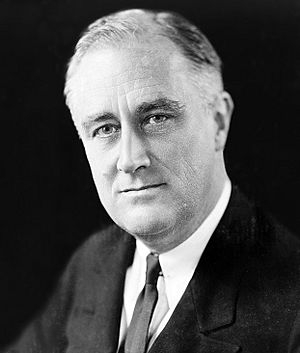
The Great Depression started in 1929 under a Republican president. This led to a big change in government. Democrats controlled the House of Representatives almost continuously from 1930 to 1994. They also won most presidential elections until 1968. Franklin D. Roosevelt, elected president in 1932, introduced government programs called the "New Deal".
The New Deal meant the government would regulate businesses, especially banks. It also supported labor unions and spent federal money to help unemployed people and farmers. It created large public works projects. This marked the beginning of the American welfare state. People who opposed these ideas, supporting businesses and low taxes, started calling themselves "conservatives".
Until the 1980s, the Democratic Party was a mix of two groups. There were liberal Democrats in the North. And there were culturally conservative voters in the South. Southern Democrats often opposed new Civil Rights laws, even though they benefited from New Deal projects. After Roosevelt died, this split grew.
After World War II, the country faced the Cold War and the Civil Rights Movement. Republicans started to attract conservatives and white Southerners. African Americans had traditionally supported the Republican Party because of Abraham Lincoln's anti-slavery policies. But they began supporting Democrats after Franklin D. Roosevelt's New Deal and President Harry S. Truman's support for civil rights. The Democratic Party's main support then shifted to the Northeast.
Modern Democrats: 1960–Present
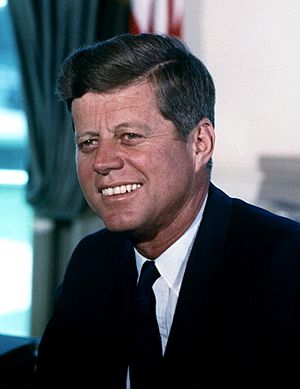
The election of President John F. Kennedy in 1960 showed this shift. Kennedy attracted younger voters. His "New Frontier" plan included social programs, public works, and support for the space program, like sending a man to the moon. He also pushed for civil rights laws. Sadly, he was assassinated in November 1963 before the Civil Rights Act of 1964 passed.
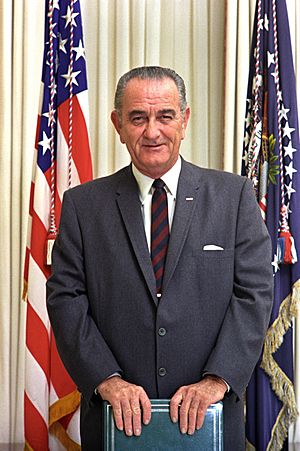
Kennedy's successor, Lyndon B. Johnson, helped pass the Civil Rights Act in 1964. In 1965, he passed many "Great Society" programs. These programs aimed to help poor people. Kennedy and Johnson's support for civil rights made African Americans strongly support Democrats. But it made many white Southerners leave the party. They later moved towards the Republican Party, especially after Ronald Reagan was elected in 1980.
The Vietnam War also caused problems for Democrats. The war became very unpopular, leading to widespread protests. This alienated many young voters. The protests, along with the assassinations of Dr. Martin Luther King, Jr. and Democratic candidate Senator Robert F. Kennedy, led to chaos at the 1968 Democratic National Convention. This marked a big change for the Democratic Party.
Republican Richard Nixon won the 1968 election. He won again in 1972. But his presidency was hit by the Watergate scandal, forcing him to resign in 1974. This gave Democrats a chance to recover. Jimmy Carter won the 1976 presidential election. He temporarily brought different parts of the party together. But inflation and the Iran Hostage Crisis of 1979–1980 hurt his popularity. This led to a big win for Republican Ronald Reagan in 1980, which changed the political landscape for years.
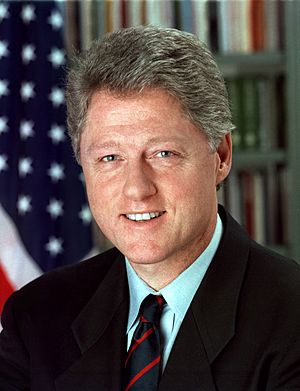
After Reagan's rise, Democrats looked for new ways to win. Arkansas Governor Bill Clinton was elected president in 1992. He called himself a "New Democrat". The party adopted a more centrist economic approach but remained socially progressive. They started to support a balanced budget and a market economy mixed with some government intervention. They also continued to focus on social justice. This economic policy was called the "Third Way".
Democrats lost control of Congress in the 1994 election. But Clinton was re-elected in 1996, the first Democrat since Franklin Roosevelt to win two terms. Democrats regained control of both the House and Senate in the 2006 elections.

After the terrorist attacks in 2001 and growing concerns about global warming, key issues for the party included fighting terrorism, homeland security, expanding health care, labor rights, and protecting the environment. Barack Obama became the first African American president in 2008. Democrats gained control of both parts of Congress after the 2007 economic recession.
Under Obama, the Democratic Party passed an Economic Stimulus package, the Dodd-Frank financial reform act, and the Affordable Care Act. In the 2010 elections, Democrats lost control of the House. In the 2012 elections, President Obama was re-elected. But in 2014, the party lost control of the Senate. After the 2016 election of Donald Trump, the Democratic Party became the opposition party.
Polls show that the Democratic Party has become more socially liberal over time. In 2014, Gallup found that 30% of Americans identified as Democrats, 23% as Republicans, and 45% as Independents.
Party Name and Symbols
At first, the party called itself the "Republican Party." But their opponents, the Federalists, called them "Democratic." They hoped this would make them seem like they supported mob rule. By the time of Andrew Jackson, the party used the name "The Democracy." The name "Democratic Party" became official in 1844. Members are called "Democrats" or "Dems."
The most common symbol for the party is the donkey. Andrew Jackson's enemies called him a "jackass" to make fun of him. But Democrats liked the idea of a common, hardworking animal. The image stuck, especially after cartoons by Thomas Nast in 1870. Cartoonists then started using the donkey for Democrats and the elephant for Republicans.
In some states, like Indiana and Kentucky, the rooster was a traditional symbol for the Democratic Party. This is different from the Republican eagle. The rooster symbol still appears on some ballots today. In New York, the Democratic symbol is a five-pointed star.
Since the 2000 election, blue has become the color for the Democratic Party. Red is used for the Republican Party. This started when TV networks used blue for states won by Al Gore (Democrat) and red for states won by George W. Bush (Republican). This is different from many other countries where red is for left-wing parties and blue is for right-wing parties. The Democratic Party uses blue in its marketing and on its official website.
In 2010, the Democratic Party introduced its first official logo: a blue "D" inside a blue circle. The donkey had only been a semi-official symbol before this.
"Jefferson-Jackson Day" is an annual fundraising event for the Democratic Party. It's named after Presidents Thomas Jefferson and Andrew Jackson, who are seen as important early leaders of the party.
The song "Happy Days Are Here Again" is the unofficial song of the Democratic Party. It was used when Franklin D. Roosevelt was nominated for president in 1932. "Don't Stop" by Fleetwood Mac was used by Bill Clinton's campaign in 1992 and is still popular. "Beautiful Day" by U2 has also become a favorite for Democratic candidates. For their conventions, Democrats often play Aaron Copland's Fanfare for the Common Man.
Images for kids
-
Andrew Jackson, founder of the Democratic Party and the first president it elected.
-
To vote for Stephen A. Douglas in Virginia, a man deposited the ticket issued by the party in the official ballot box
-
Thomas Nast's January 1870 depiction of the Democratic donkey
-
Typewriters were new in 1893 and this Gillam cartoon from Puck shows that Grover Cleveland can not get the Democratic "machine" to work as the keys (key politicians) will not respond to his efforts
-
William Jennings Bryan at age 36 was the youngest candidate, October 1896
-
Adlai Stevenson warns against a return of the Republican policies of Herbert Hoover, 1952 campaign poster
-
President John F. Kennedy with his brothers, Attorney General and later New York Senator Robert F. Kennedy and Massachusetts Senator Ted Kennedy
-
President Jimmy Carter was elected in 1976 and defeated in 1980
-
Representative Thomas "Tip" O'Neill was Speaker of the House (1977–1987) and was the highest ranking Democrat in Washington, D.C. during most of Reagan's term
-
Nancy Pelosi of California was the first woman to serve as Speaker of the House of Representatives
-
On November 4, 2008, Barack Obama was elected as the first African American president of the United States
-
Former Secretary of State Hillary Clinton
-
Senator Bernie Sanders
-
Nancy Pelosi, the current House Speaker (2019–present), was highly visible adversary for President Trump.



